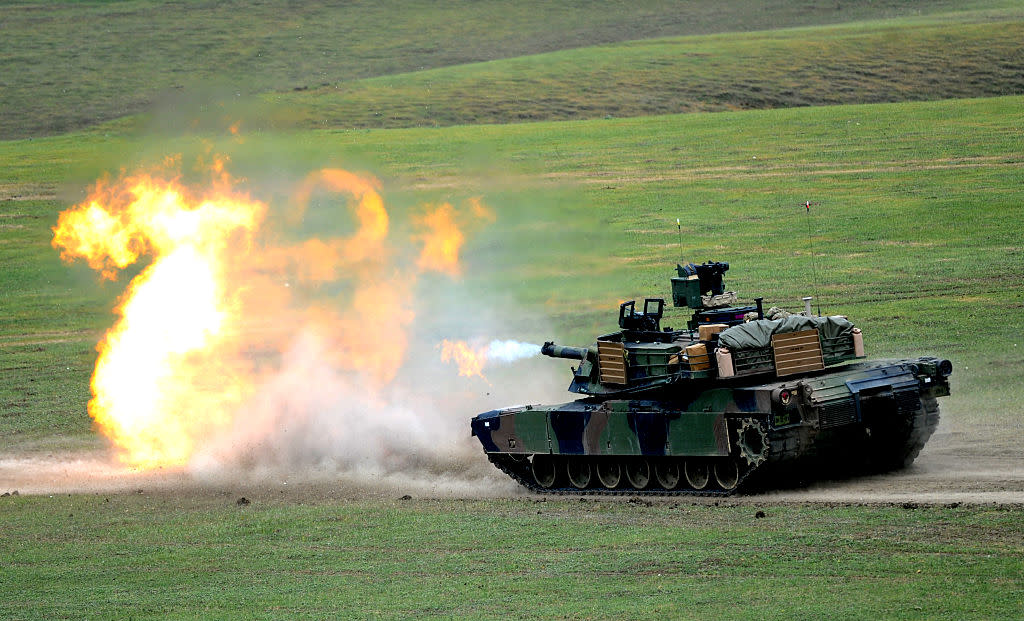Biden Just Promised Abrams Tanks to Ukraine. They Won't Get There for Months

A U.S. M1A2 Abrams tank fires during the Noble Partner 2016 joint military exercise at the Vaziani training area outside Tbilisi on May 18, 2016. Some 500 Georgian, 650 US and 150 British troops are taking part in the drills, billed as the largest ever to be held in the Caucasus nation, which fought a brief war with Russia in 2008. Credit - Vano Shlamov–AFP/Getty Images
The Biden Administration reversed course on its policy stance on whether to send M1 Abrams tanks to Ukraine after publicly arguing for weeks that such a move would hinder Ukrainian forces more than help.
President Joe Biden announced Wednesday the U.S. will provide 31 American-made battle tanks as part of a long-term plan to strengthen the Ukrainian army with advanced weaponry to fight invading Russian forces, which occupy vast swaths of eastern and southern Ukraine. The policy turnaround is the latest sign the White House expects the conflict in Ukraine to last for many months or years, and signals Washington is prepared to support Ukraine in the fight for its duration.
The influx of armor will “enhance Ukraine’s capacity to defend its territory and achieve its strategic objectives,” Biden said, calling Abrams “the most capable tanks in the world.”
“That’s what this is about,” he said, “helping Ukraine defend and protect Ukrainian land.”
The $400 million package includes funding for 31 Abrams tanks—the size of a Ukrainian tank battalion—ammunition rounds, support vehicles, and other equipment. It will all be procured through the Ukraine Security Assistance Initiative, which is a U.S. funding program to purchase weapons from contractors. Ukraine has received much of its current American-made arsenal through another less cumbersome program that draws down on existing U.S. military stocks so the hardware can quickly get to the Ukrainian frontlines.
“We’re talking months, as opposed to weeks,” a senior Administration official told reporters ahead of Biden’s announcement. “If we do not have it readily within U.S. stocks, then we go the procurement route to make sure that we can procure the right capability for Ukraine.”
Read More: Exclusive: AWOL Navy SEAL Killed Fighting In Ukraine
Under this longer timeline, the new Abrams tanks aren’t likely to arrive ahead of an expected spring offensive by Russian forces. Ukraine has been pleading the U.S. and Western partners for new armor since the early stages of Russian President Vladimir Putin’s invasion last February. The Ukrainian military currently operates a Soviet-era tank fleet, which is expected to be over-matched in the coming months when Russia’s mobilizes its offensive in the east.
The Abrams tank weighs more than 60 tons with a 120 millimeter cannon that can hit targets a mile away. At around 45 miles per hour, it’s faster than older tanks with specialized armor-plating designed to withstand direct hits with antitank weapons. Administration officials said the Ukrainian troops’ Abrams training will take place “outside” Ukraine, but wouldn’t say whether it will be held in United States, like the ongoing Patriot system training. “Delivering these tanks to the field is going to take time,” Biden said in his speech at the White House. “Time that we’ll use to make sure the Ukrainians are fully prepared.”
As recently as last week, the Biden Administration had insisted the Abrams tank was too complicated, too expensive, and too difficult to train Ukrainian forces to use. A major issue they cited is that the turbine engine guzzles jet fuel rather than diesel like the German-made Leopard tank. The Pentagon contended that Leopards consume less fuel, are easier to maintain, and, perhaps most importantly, are already widely available across Europe because more than a dozen European nations operate them and many are willing to send them to Ukraine.
In the end, however, the White House determined the maintenance and logistics concerns weren’t significant enough barriers to prevent sending the Abrams, senior Administration officials said. “We are supporting the Ukrainians to be able to synchronize all of their different capabilities… in a unified way that will enable them to retake territory,” the senior official said.
Ben Hodges, a retired lieutenant general who once commanded all U.S. Army forces in Europe, says the decision to send Abrams is welcome news but should have come sooner. “Unfortunately, the amount of time it took to get to this decision—and the way it is going to be implemented—does not convey a sense of urgency by the Administration or the Pentagon to help Ukraine win,” he says. “It feels more like the path of helping Ukraine avoid losing.”
Read More: Why Russia Is Battling To Capture A Small Ukrainian Mining Town
Only in recent weeks have Western countries committed to sending tanks and armored vehicles to Ukraine. Earlier this month, the U.S., France, and Germany agreed to send a delivery of armored fighting vehicles, which can help transport infantry into combat zones while firing at enemy forces. The hope is the influx of heavy weapons will tip the fighting in Kyiv’s favor and enable Ukrainian forces to retake occupied territory.
In providing Abrams, Biden opened the door for other allied nations to send their own additional firepower to Kyiv. German Chancellor Olaf Scholz announced his nation will provide 14 Leopard 2 battle tanks after intense negotiations with the U.S. and other North Atlantic Treaty Organization (NATO) partners. Scholz had privately insisted that Washington provide U.S. tanks first, according to U.S. officials, before he would greenlight sending German-made tanks. “It was necessary to take our time to reach a coordinated approach,” Scholz told German lawmakers Wednesday in the Bundestag. “We are not alone.”
The decision in Berlin will also ease a weeks-long logjam with other European nations that were awaiting Scholz’s approval to send their German-made Leopards to Ukraine. Germany needs to first train Ukrainian soldiers on how to operate and maintain the tanks, before sending them to the eastern front, which Germany expects will take roughly three months.


